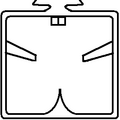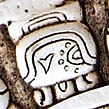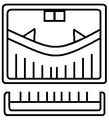Haab
The Haab ("solar year") is a part of the Mayan calendar that the Maya used for civil purposes (the other part is the Tzolkin ). He divides the year into 18 “months” with 20 days each ( Kin ), which corresponds to 360 days. In order to approximate the solar year with about 365¼ days, a 19th “month” with only 5 days ( Uayeb “nameless”) is added. Since these 5 days are added every year, they are epagomens and not leap days , which, in contrast, are only inserted in leap years. Without a switching control , there is an always constant year length of 365 days, which is why the "year" in the Haab is similar to the solar year, but the Haab is still not a solar calendar (like our Gregorian calendar ). Theoretically, due to the fixed year length and the approximately 6 missing hours per year, there should have been a shift between the calendar year and the solar year (→ change year ).
A date in the Haab calendar is e.g. B. 11 Yax .
Day counting
In the daily count of the Haab calendar, the numbers run continuously from 0 to 19 and the 18 months in the order: Pop , Uo , Zip , Zotz , Zec , Xul , Yaxkin , Mol , Chen , Yax , Zac , Ceh , Mac , Kankin , Muan , Pax , Kayab , Cumku . In addition, there is the month of Uayeb / Wayeb ("unlucky days"; leap month with only 5 days).
In the Haab the days are therefore designated as follows:
| 0 pop, | 1 pop, | 2 pop, | 3 pop, | ..., | 19 pop, |
| 0 Uo, | 1 Uo, | 2 Uo, | 3 Uo, | ..., | 19 Uo, |
| ... | |||||
| 0 cumku, | 1 cumku, | 2 cumku, | 3 cumku, | ..., | 19 Cumku, |
| 0 Uayeb, | 1 uayeb, | 2 uayeb, | 3 Uayeb, | 4 uayeb. | |
The Haab and Tzolkin calendars are aligned so that after each calendar round (every 52 Haab years) the date 8 Cumku (Haab) indicates the same day as the date 4 Ahau (Tzolkin).
Around the time of the conquest by Spain , the Maya began to number the days from 1, so that the Haab year began with 1 Pop and ended with 5 Uayeb .



















